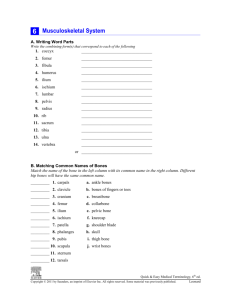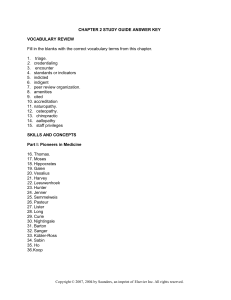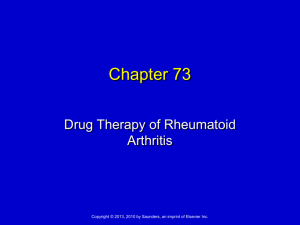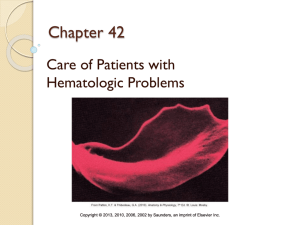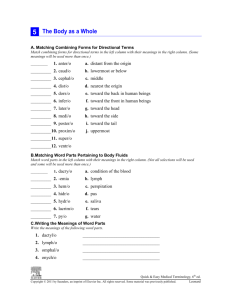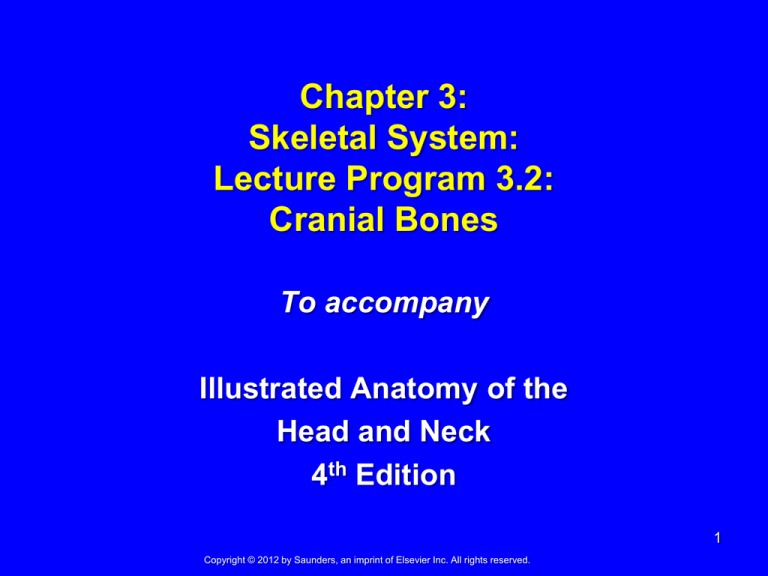
Chapter 3:
Skeletal System:
Lecture Program 3.2:
Cranial Bones
To accompany
Illustrated Anatomy of the
Head and Neck
4th Edition
1
Copyright © 2012 by Saunders, an imprint of Elsevier Inc. All rights reserved.
Lecture Program 3.2:
Outline
BONES OF HEAD AND NECK
Cranial Bones
2
Copyright © 2012 by Saunders, an imprint of Elsevier Inc. All rights reserved.
Lecture Program 3.2:
Learning Objectives
1.
2.
4.
5.
6.
Define and pronounce the key terms and anatomic
terms in this lecture.
Locate and identify the bones of the head and neck
and their landmarks on a diagram, skull, and patient.
Discuss the skeletal system pathology associated
with the head and neck.
Correctly complete the review questions and
activities for this lecture.
Integrate an understanding of the skeletal system
into the overall study of the head and neck anatomy
and clinical dental practice.
3
Copyright © 2012 by Saunders, an imprint of Elsevier Inc. All rights reserved.
Bones of the Head and Neck
Cranial Bones
4
Copyright © 2012 by Saunders, an imprint of Elsevier Inc. All rights reserved.
Cranial Bones
The cranium is
formed from the
eight cranial bones.
The cranial bones
include the single
occipital, frontal,
sphenoid, and
ethmoid as well as
the paired parietal
and temporal.
Figure 3-20: Lateral View
5
Copyright © 2012 by Saunders, an imprint of Elsevier Inc. All rights reserved.
Cranial Bones Review
ID 3
6
Copyright © 2012 by Saunders, an imprint of Elsevier Inc. All rights reserved.
Cranial Bones
Occipital Bone
7
Copyright © 2012 by Saunders, an imprint of Elsevier Inc. All rights reserved.
Occipital Bone
The occipital bone
is a single cranial
bone that forms the
posterior part of the
skull and the base of
the cranium.
Figure 3-21: Lateral View
8
Copyright © 2012 by Saunders, an imprint of Elsevier Inc. All rights reserved.
Occipital Bone: Articulations
The occipital bone articulates with
the parietal, temporal, and sphenoid of the skull.
Figure 3-21: Lateral View
Figure 3-22: Inferior View
9
Copyright © 2012 by Saunders, an imprint of Elsevier Inc. All rights reserved.
Occipital Bone: Articulations
The occipital bone
also articulates with
the first cervical
vertebra or atlas.
Figure 3-62: Posterior View
10
Copyright © 2012 by Saunders, an imprint of Elsevier Inc. All rights reserved.
Occipital Bone: Articulations
Posterior View
Drake RL, et al. Gray’s Anatomy for Students, ed 2,
Churchill Livingson, 2010
Copyright © 2012 by Saunders, an imprint of Elsevier Inc. All rights reserved.
11
Occipital Bone from Inferior View
On the external
surface of the
occipital bone from
an inferior view, it
can be seen that the
foramen magnum
is completely formed
by this bone.
Figure 3-22
Copyright © 2012 by Saunders, an imprint of Elsevier Inc. All rights reserved.
12
Occipital Bone from Inferior View
Lateral and anterior to the foramen magnum
are the paired occipital condyles, curved
and smooth projections.
The occipital condyles have a movable
articulation with the atlas, the first cervical
vertebra of the vertebral column (discussed
later).
On the stout basilar part, a four-sided plate
anterior to the foramen magnum is a midline
projection, the pharyngeal tubercle.
13
Copyright © 2012 by Saunders, an imprint of Elsevier Inc. All rights reserved.
Occipital Bone from Inferior View
Figure 3-22
14
Copyright © 2012 by Saunders, an imprint of Elsevier Inc. All rights reserved.
Occipital Bone from Inferior View
These openings are the paired hypoglossal
canals.
The twelfth cranial or hypoglossal nerve is
transmitted through the hypoglossal canal.
Also present is the jugular notch of the
occipital bone, the medial part of the two
bones that form the jugular foramen (the
lateral part is from the temporal bone).
15
Copyright © 2012 by Saunders, an imprint of Elsevier Inc. All rights reserved.
Occipital Bone from Inferior View
Figure 3-22
16
Copyright © 2012 by Saunders, an imprint of Elsevier Inc. All rights reserved.
Occipital Bone from Inferior View
Review
ID 4
17
Copyright © 2012 by Saunders, an imprint of Elsevier Inc. All rights reserved.
Cranial Bones
Frontal Bone
18
Copyright © 2012 by Saunders, an imprint of Elsevier Inc. All rights reserved.
Frontal Bone
The frontal bone or
nasofrontal bone is a
single cranial bone that
forms the anterior part
of the skull superior to
the eyes in the frontal
region, and includes the
forehead, the roof of the
orbits, and part of the
nasal cavity.
Figure 3-23: Lateral View
19
Copyright © 2012 by Saunders, an imprint of Elsevier Inc. All rights reserved.
Frontal Bone
Figure 2-2: Frontal Views
Figure 2-6: Frontal Views
Copyright © 2012 by Saunders, an imprint of Elsevier Inc. All rights reserved.
20
Frontal Bone: Articulations
The frontal bone
articulates with the
parietal bones,
sphenoid bone,
lacrimal bones,
nasal bones,
ethmoid bone,
zygomatic bones,
and maxillae.
Figure 3-23: Lateral View
21
Copyright © 2012 by Saunders, an imprint of Elsevier Inc. All rights reserved.
Frontal Bone: Articulations
Anterior View
Applegate EJ. The Anatomy and Physiology Learning System, ed 3. Elsevier, 2006
Copyright © 2012 by Saunders, an imprint of Elsevier Inc. All rights reserved.
22
Frontal Bone
The frontal bone’s
part of the superior
temporal line and
inferior temporal
line is visible when
the bone is viewed
from the lateral
aspect.
Figure 3-23: Lateral View
23
Copyright © 2012 by Saunders, an imprint of Elsevier Inc. All rights reserved.
Frontal Sinuses
Internally, the frontal
bone contains the
paired paranasal
sinuses, the frontal
sinuses.
Figure 3-23: Lateral View
24
Copyright © 2012 by Saunders, an imprint of Elsevier Inc. All rights reserved.
Dissection
Frontal Sinus
Figure 3-66: Sagittal Section
25
Copyright © 2012 by Saunders, an imprint of Elsevier Inc. All rights reserved.
Frontal Bone from Anterior View
The orbital plate of
the frontal bone forms
the superior wall or
orbital roof.
The curved elevations
over the superior part
of the orbit are the
supraorbital ridges,
subjacent to the
eyebrows.
Figure 3-24
26
Copyright © 2012 by Saunders, an imprint of Elsevier Inc. All rights reserved.
Frontal Bone from Anterior View
The supraorbital
notch is located on
the medial part of
the supraorbital
ridge and is where
the supraorbital
artery and nerve
travel from the orbit
to the forehead.
Figure 3-24
27
Copyright © 2012 by Saunders, an imprint of Elsevier Inc. All rights reserved.
Frontal Bone from Anterior View
Between the
supraorbital ridges is
the glabella, the
smooth elevated area
between the
eyebrows.
The prominence of
the forehead, the
frontal eminence, is
also evident.
Figure 3-24
28
Copyright © 2012 by Saunders, an imprint of Elsevier Inc. All rights reserved.
Frontal Bone from Anterior View
Lateral to the orbit is
a projection, the
orbital surface of the
zygomatic process
of the frontal bone.
Figure 3-24
29
Copyright © 2012 by Saunders, an imprint of Elsevier Inc. All rights reserved.
Frontal Bone from Inferior View
From the inferior view of
the frontal bone, each
lacrimal fossa is
visible.
The lacrimal fossa is
located just inside the
lateral part of the
supraorbital ridge.
This fossa contains the
lacrimal gland, which
produces lacrimal fluid
or tears.
Figure 3-25
30
Copyright © 2012 by Saunders, an imprint of Elsevier Inc. All rights reserved.
Cranial Bones
Parietal Bones
31
Copyright © 2012 by Saunders, an imprint of Elsevier Inc. All rights reserved.
Parietal Bones
The parietal bones
each have four
borders and are
shaped like a curved
plate.
Each bone’s part of
the superior
temporal line and
inferior temporal line
is visible.
Figure 3-26: Posterior View
32
Copyright © 2012 by Saunders, an imprint of Elsevier Inc. All rights reserved.
Parietal Bones: Articulations
The parietal bones
are paired cranial
bones that articulate
with each other at
the sagittal suture.
Figure 3-26: Posterior View
33
Copyright © 2012 by Saunders, an imprint of Elsevier Inc. All rights reserved.
Parietal Bones: Articulations
Posterior View
Drake RL, et al. Gray’s Anatomy for Students, ed 2,
Churchill Livingson, 2010
Copyright © 2012 by Saunders, an imprint of Elsevier Inc. All rights reserved.
34
Parietal Bones: Articulations
The parietal bones
also articulate with
the occipital, frontal,
temporal, and
sphenoid bones;
they articulate with
the occipital bone at
the lambdoidal
sutures.
Figure 3-12: Lateral View
35
Copyright © 2012 by Saunders, an imprint of Elsevier Inc. All rights reserved.
Cranial Bones
Temporal Bones
36
Copyright © 2012 by Saunders, an imprint of Elsevier Inc. All rights reserved.
Temporal Bones
The temporal
bones are paired
cranial bones that
form the lateral walls
of the skull in the
temporal region and
part of the base of
the skull in the
auricular region.
Figure 3-27: Lateral View
37
Copyright © 2012 by Saunders, an imprint of Elsevier Inc. All rights reserved.
Temporal Bone: Articulations
Each temporal bone
articulates with one
zygomatic and one
parietal bone, the
occipital and
sphenoid bones,
and the mandible.
Figure 3-27: Lateral View
38
Copyright © 2012 by Saunders, an imprint of Elsevier Inc. All rights reserved.
Temporal Bones: Articulations
Anterior View
Applegate EJ. The Anatomy and Physiology Learning System, ed 3. Elsevier, 2006
Copyright © 2012 by Saunders, an imprint of Elsevier Inc. All rights reserved.
39
Temporal Bones: Articulations
Posterior View
Drake RL, et al. Gray’s Anatomy for Students, ed 2,
Churchill Livingson, 2010
Copyright © 2012 by Saunders, an imprint of Elsevier Inc. All rights reserved.
40
Temporal Bone
Each temporal bone
is composed of four
parts: the
squamous,
tympanic, petrous,
and mastoid
process.
Figure 3-28: Lateral View
41
Copyright © 2012 by Saunders, an imprint of Elsevier Inc. All rights reserved.
Temporal Bone
The large, fan-shaped, flat part on each of the
temporal bones is the squamous part of the
temporal bone.
The second part is the small, irregularly
shaped tympanic part of the temporal
bone, which is associated with the ear canal.
The third part is the petrous part of the
temporal bone, which is inferiorly located
and helps form the cranial floor.
42
Copyright © 2012 by Saunders, an imprint of Elsevier Inc. All rights reserved.
Temporal Bone
Figure 3-28: Lateral View
43
Copyright © 2012 by Saunders, an imprint of Elsevier Inc. All rights reserved.
Squamous Part of Temporal Bone
In addition to
helping form the
braincase, the
squamous part of
the temporal bone
forms the
zygomatic process
of the temporal
bone, which forms a
part of the
zygomatic arch.
Figure 3-29: Lateral View
44
Copyright © 2012 by Saunders, an imprint of Elsevier Inc. All rights reserved.
Squamous Part of Temporal Bone
The squamous part of the
temporal bone also forms
the cranial part of the
temporomandibular
joint.
On the inferior surface of
the zygomatic process of
the temporal bone is the
articular fossa.
Figure 5-2: Inferolateral View
45
Copyright © 2012 by Saunders, an imprint of Elsevier Inc. All rights reserved.
Squamous Part of Temporal Bone
Anterior to the
articular fossa is the
articular eminence,
and posterior is the
postglenoid
process.
Figure 5-4
46
Copyright © 2012 by Saunders, an imprint of Elsevier Inc. All rights reserved.
Tympanic Part of Temporal Bone
The tympanic part of
the temporal bone
forms most of the
external acoustic
meatus (EAM), a
short canal leading
to the tympanic
cavity, located
posterior to the
articular fossa.
Figure 3-30: Lateral View
47
Copyright © 2012 by Saunders, an imprint of Elsevier Inc. All rights reserved.
External Acoustic Meatus (EAM)
Figure 2-4
48
Copyright © 2012 by Saunders, an imprint of Elsevier Inc. All rights reserved.
Tympanic Part of Temporal Bone
Posterior to the
articular fossa, the
tympanic part is
separated from the
petrosal part by a
fissure, the
petrotympanic
fissure, through
which the chorda
tympani nerve
emerges.
Figure 3-30: Lateral View
49
Copyright © 2012 by Saunders, an imprint of Elsevier Inc. All rights reserved.
Petrous Part of Temporal Bone
On the inferior aspect
of the petrous part of
the temporal bone and
posterior to the
external acoustic
meatus is a large
roughened projection,
the mastoid process.
Figure 3-31: Inferior Views
50
Copyright © 2012 by Saunders, an imprint of Elsevier Inc. All rights reserved.
Imaging
Petrous Part of Temporal Bone
The mastoid process is
composed of air spaces
or mastoid air cells
that communicate with
the middle ear cavity
and also serve as the
site for attachment of
the large muscles of the
neck such as the
sternocleidomastoid
muscle.
Drake RL, et al. Gray’s Anatomy for Students, ed 2,
Churchill Livingson, 2010
Copyright © 2012 by Saunders, an imprint of Elsevier Inc. All rights reserved.
51
Petrous Part of Temporal Bone
Medial to the
mastoid process is
the mastoid notch.
Inferior and medial
to the external
acoustic meatus is a
long, pointed bony
projection, the
styloid process.
Figure 3-31: Inferior Views
52
Copyright © 2012 by Saunders, an imprint of Elsevier Inc. All rights reserved.
Petrous Part of Temporal Bone
The stylomastoid
foramen is named
for its location
between the styloid
process and
mastoid process.
Figure 3-31: Inferior Views
53
Copyright © 2012 by Saunders, an imprint of Elsevier Inc. All rights reserved.
Petrous Part of Temporal Bone
The large circular
aperture of the
carotid canal is
also noted, which
ascends at first
vertically, and then,
making a bend, runs
horizontally forward
and medialward.
Figure 3-31: Inferior Views
54
Copyright © 2012 by Saunders, an imprint of Elsevier Inc. All rights reserved.
Petrous Part of Temporal Bone
The jugular notch
of the temporal
bone is visible,
which is the lateral
part of the two
bones that form the
jugular foramen (the
medial part is from
the occipital bone).
Figure 3-31: Inferior Views
55
Copyright © 2012 by Saunders, an imprint of Elsevier Inc. All rights reserved.
Petrous Part of Temporal Bone
On the intracranial
surface of the petrous
part of the temporal
bone is the internal
acoustic meatus
(IAM), which carries
the eighth cranial or
vestibulocochlear
nerve and the seventh
cranial or facial nerve.
Figure 3-19: Superior View
of the Internal Skull
Copyright © 2012 by Saunders, an imprint of Elsevier Inc. All rights reserved.
56
Clinical Note:
Mastoiditis
Infection within the mastoid antrum and
mastoid cells is usually secondary to infection
in the middle ear (otitis media).
The mastoid cells provide an excellent culture
medium for infection.
Infection of the bone (osteomyelitis) may also
develop, spreading into the middle cranial
fossa.
57
Copyright © 2012 by Saunders, an imprint of Elsevier Inc. All rights reserved.
Temporal Bones Review
ID 5
58
Copyright © 2012 by Saunders, an imprint of Elsevier Inc. All rights reserved.
Cranial Bones
Sphenoid Bone
59
Copyright © 2012 by Saunders, an imprint of Elsevier Inc. All rights reserved.
Sphenoid Bone
The sphenoid bone is very complex, with
some parts of it encountered in almost every
significant area of the skull.
It consists of a body and its processes.
It has a number of features and projections,
which allows it to be seen from various views
of the skull.
It is very difficult to describe and visualize.
60
Copyright © 2012 by Saunders, an imprint of Elsevier Inc. All rights reserved.
Sphenoid Bone
The single sphenoid
bone is a midline bone
since it runs through the
midsagittal section and
thus is internally
wedged between
several other bones in
the anterior part of the
cranium.
Figure 3-15: Inferior View
Figure 1-6
Copyright © 2012 by Saunders, an imprint of Elsevier Inc. All rights reserved.
61
Disarticulated Posterosuperior View
Figure 3-33C
Lateral Aspect
Figure 3-34B
The sphenoid bone somewhat resembles a bat
with its wings extended; others see a butterfly
taking wing.
62
Copyright © 2012 by Saunders, an imprint of Elsevier Inc. All rights reserved.
Sphenoid Bone
Figure 3-33: Superior Views of Internal Skull
63
Copyright © 2012 by Saunders, an imprint of Elsevier Inc. All rights reserved.
Sphenoid Bone
Figure 3-34: Lateral Aspect with Cutaway View
64
Copyright © 2012 by Saunders, an imprint of Elsevier Inc. All rights reserved.
Sphenoid Bone: Articulations
The sphenoid bone
articulates with the
frontal, parietal,
ethmoid, temporal,
zygomatic, maxillae,
palatine, vomer, and
occipital bones.
Figure 3-3: Frontal View
65
Copyright © 2012 by Saunders, an imprint of Elsevier Inc. All rights reserved.
Sphenoid Bone: Articulations
Figure 3-32: Inferior Views of
External Skull
Figure 3-33: Superior Views of
Internal Skull
66
Copyright © 2012 by Saunders, an imprint of Elsevier Inc. All rights reserved.
Sphenoid Bone
As a cranial bone,
the sphenoid bone
helps to connect the
cranial skeleton to
the facial skeleton.
See skull exploded.
Figure 3-20: Lateral View
67
Copyright © 2012 by Saunders, an imprint of Elsevier Inc. All rights reserved.
Body of Sphenoid Bone
In the middle part is
the body of the
sphenoid bone.
It articulates on its
anterior surface with
the ethmoid bone.
It articulates
posteriorly with the
basilar part of the
occipital bone.
Figure 3-33: Superior Views
68
Copyright © 2012 by Saunders, an imprint of Elsevier Inc. All rights reserved.
Body of Sphenoid Bone
Location of sphenoidal sinuses
Greater wing
Optic canal
Superior orbital fissure
Body
Foramen rotundum
Foramen ovale
Foramen spinosum
Lateral pterygoid plate
Medial pterygoid plate
Hamulus
Disarticulated Posterosuperior View
Figure 3-33C
69
Copyright © 2012 by Saunders, an imprint of Elsevier Inc. All rights reserved.
Body of Sphenoid Bone
Greater wing
Body
Lateral pterygoid plate
Hamulus
Lateral Aspect
Figure 3-34B
Copyright © 2012 by Saunders, an imprint of Elsevier Inc. All rights reserved.
70
Body of Sphenoid Bone
The body of
sphenoid contains
the paired paranasal
sinuses, the
sphenoidal
sinuses.
Figure 3-55B: Lateral View
71
Copyright © 2012 by Saunders, an imprint of Elsevier Inc. All rights reserved.
Sphenoidal Sinuses
The sphenoidal sinuses
are posterior to the
ethmoidal sinuses,
superior to the
nasopharynx, and
posterior to the orbits.
They are frequently
asymmetrical (around
1.5–2.5 cm in
diameter).
Figure 3-66: Sagittal Section
72
Copyright © 2012 by Saunders, an imprint of Elsevier Inc. All rights reserved.
Sphenoidal Sinuses
The sphenoid
sinuses
communicate with
and drain into the
nasal cavity (red
dotted arrow)
through an opening
superior to each
superior nasal
concha.
Figure 3-38: Lateral Wall of
Nasal Cavity
73
Copyright © 2012 by Saunders, an imprint of Elsevier Inc. All rights reserved.
Dissection
Sphenoidal Sinuses
**
The sphenoidal
sinuses cannot be
palpated during an
extraoral
examination.
Sagittal section from the Visible
Human Projectsee related PPT
74
Copyright © 2012 by Saunders, an imprint of Elsevier Inc. All rights reserved.
Imaging
Sphenoidal Sinuses
The sphenoidal
sinuses cannot be
palpated during an
extraoral
examination.
**
Lateral View
Mosby's Dental Dictionary, 2nd edition. 2008 Elsevier, Inc.
75
Copyright © 2012 by Saunders, an imprint of Elsevier Inc. All rights reserved.
Clinical Note:
Sphenoidal Sinusitis
Infection in the
paranasal sinuses can
cause earaches, neck
pain, and deep aching
at the back of the head,
although these sinuses
are less frequently
affected.
In addition, the drainage
of mucus down the
posterior wall of the
pharynx (postnasal drip)
can cause pharyngitis
(sore throat).
**
From the Visible Human Projectsee related PPT
76
Copyright © 2012 by Saunders, an imprint of Elsevier Inc. All rights reserved.
Sphenoid Bone Processes
The body of the
sphenoid bone has
three paired
processes projecting
from it.
The anterior process
is the lesser wing.
The posterolateral
process is the
greater wing.
Figure 3-33: Superior Views
77
Copyright © 2012 by Saunders, an imprint of Elsevier Inc. All rights reserved.
Sphenoid Bone Processes
Location of sphenoidal sinuses
Greater wing
Optic canal
Superior orbital fissure
Body
Foramen rotundum
Foramen ovale
Foramen spinosum
Lateral pterygoid plate
Medial pterygoid plate
Hamulus
Figure 3-33C: Posterosuperior View
78
Copyright © 2012 by Saunders, an imprint of Elsevier Inc. All rights reserved.
Sphenoid Bone Processes
Body
Greater wing
Lateral pterygoid plate
Hamulus
Figure 3-34B: Lateral Aspect
Copyright © 2012 by Saunders, an imprint of Elsevier Inc. All rights reserved.
79
Sphenoid Bone Processes
Inferior to the greater
wing of the sphenoid
bone is the pterygoid
process.
The pterygoid process
consists of two plates,
the flattened lateral
pterygoid plate and
thinner medial
pterygoid plate, with
the pterygoid fossa
between them.
Figure 3-32: Inferior Views
80
Copyright © 2012 by Saunders, an imprint of Elsevier Inc. All rights reserved.
Sphenoid Bone Processes
Figure 3-32: Inferior Views
81
Copyright © 2012 by Saunders, an imprint of Elsevier Inc. All rights reserved.
Sphenoid Bone Processes
The (pterygoid)
hamulus, a thin
curved process, is
the inferior
termination of the
medial pterygoid
plate.
Figure 3-34: Lateral Views
82
Copyright © 2012 by Saunders, an imprint of Elsevier Inc. All rights reserved.
Sphenoid Bone Processes
The
pterygopalatine
fossa is between
the pterygoid
process and the
maxillary tuberosity.
Figure 3-61: Oblique View
83
Copyright © 2012 by Saunders, an imprint of Elsevier Inc. All rights reserved.
Sphenoid Bone Processes
Location of sphenoidal sinuses
Greater wing
Optic canal
Superior orbital fissure
Body
Foramen rotundum
Foramen ovale
Foramen spinosum
Lateral pterygoid plate
Medial pterygoid plate
Hamulus
Figure 3-33C: Posterosuperior View
84
Copyright © 2012 by Saunders, an imprint of Elsevier Inc. All rights reserved.
Sphenoid Bone Processes
Body
Greater wing
Lateral pterygoid plate
Hamulus
Figure 3-34B: Lateral Aspect
Copyright © 2012 by Saunders, an imprint of Elsevier Inc. All rights reserved.
85
Sphenoid Bone Processes
A sharp pointed area,
the (angular) spine of
the sphenoid bone, is
located at the posterior
corner of each greater
wing of the sphenoid
bone.
Each greater wing is
divided into two smaller
surfaces by the
infratemporal crest,
the temporal and
infratemporal surfaces.
Figure 3-34: Lateral Views
86
Copyright © 2012 by Saunders, an imprint of Elsevier Inc. All rights reserved.
Sphenoid Bone Processes
Figure 3-18: Inferior View
87
Copyright © 2012 by Saunders, an imprint of Elsevier Inc. All rights reserved.
Sphenoid Bone Processes
Figure 3-32B: Inferior View
88
Copyright © 2012 by Saunders, an imprint of Elsevier Inc. All rights reserved.
Sphenoid Bone Foramina
Many foramina, fissures
are located in the
sphenoid bone, such as
the superior orbital
fissure (with ophthalmic
nerve), foramen
rotundum (with
maxillary nerve), and
foramen ovale (with
mandibular nerve).
Foramen
lacerum
Figure 3-33A: Superior View
89
Copyright © 2012 by Saunders, an imprint of Elsevier Inc. All rights reserved.
Sphenoid Bone Foramina
Figure 3-33: Superior Views of Internal Skull
90
Copyright © 2012 by Saunders, an imprint of Elsevier Inc. All rights reserved.
Sphenoid Bone Foramina
The most anterior curved and slitlike opening, the
superior orbital fissure, transmits the
ophthalmic division of the trigeminal nerve, the
abducens, trochlear, and oculomotor nerves.
The smaller round opening, the foramen
rotundum, transmits the maxillary nerve or
division of the trigeminal nerve.
The larger oval opening, the foramen ovale,
transmits the mandibular nerve or division of the
trigeminal nerve.
91
Copyright © 2012 by Saunders, an imprint of Elsevier Inc. All rights reserved.
Sphenoid Bone Foramina
Location of sphenoidal sinuses
Greater wing
Optic canal
Superior orbital fissure
Body
Foramen rotundum
Foramen ovale
Foramen spinosum
Lateral pterygoid plate
Medial pterygoid plate
Hamulus
Figure 3-33C; Posterosuperior View
92
Copyright © 2012 by Saunders, an imprint of Elsevier Inc. All rights reserved.
Sphenoid Bone Foramina
A. Anterior view. B. Posterosuperior view.
Drake RL, et al. Gray’s Anatomy for Students, ed 2,
Churchill Livingson, 2010
Copyright © 2012 by Saunders, an imprint of Elsevier Inc. All rights reserved.
93
Sphenoid Bone and Orbit
The orbital surface of
the greater wing creates
the posterior part of the
lateral wall of the
orbit.
The lesser wing forms
the base of the orbital
apex, the deepest part
of the orbit.
Figure 3-7: Frontal View
94
Copyright © 2012 by Saunders, an imprint of Elsevier Inc. All rights reserved.
Sphenoid Bone and Orbit
The round opening in the
orbital apex is the optic
canal, which lies between
the two roots of the lesser
wing.
The second cranial or
optic nerve passes
through the optic canal to
reach the eyeball.
The ophthalmic artery
also extends through the
canal to reach the eye.
Figure 3-7: Frontal View
95
Copyright © 2012 by Saunders, an imprint of Elsevier Inc. All rights reserved.
Sphenoid Bone and Orbit
Figure 3-5: Frontal View
96
Copyright © 2012 by Saunders, an imprint of Elsevier Inc. All rights reserved.
Sphenoid Bone and Orbit
Frontal view
Figure 3-6
97
Copyright © 2012 by Saunders, an imprint of Elsevier Inc. All rights reserved.
Muscles of Mastication and
Sphenoid Bone
The medial pterygoid
muscle originates from
the pterygoid fossa.
The superior head of
the lateral pterygoid
muscle originates from
the inferior surface of
the greater wing.
The inferior head
originates from the
lateral surface of the
lateral pterygoid plate.
Figure 4-23: Lateral View
98
Copyright © 2012 by Saunders, an imprint of Elsevier Inc. All rights reserved.
Sphenoid Bone
The superior surface
of the body of the
sphenoid presents
in front a prominent
spine, the ethmoidal
spine, for
articulation with the
cribriform plate of
the ethmoid bone.
*
From Gray’s Anatomy
Standring S: Gray's Anatomy, ed 40, Edinburgh, 2009, Churchill Livingstone
Copyright © 2012 by Saunders, an imprint of Elsevier Inc. All rights reserved.
99
Sphenoid Bone
On the sphenoid
bone there is an
elevation, the
tuberculum sellae;
and still more
posteriorly, a deep
depression, the sella
turcica (or pituitary
fossa).
*
From Gray’s Anatomy
Standring S: Gray's Anatomy, ed 40, Edinburgh, 2009, Churchill Livingstone
Copyright © 2012 by Saunders, an imprint of Elsevier Inc. All rights reserved.
100
Sella Turcica
*
Figure 3-33C: Posterosuperior View
101
Copyright © 2012 by Saunders, an imprint of Elsevier Inc. All rights reserved.
Sella Turcica
*
Figure 3-34B: Lateral Aspect
Copyright © 2012 by Saunders, an imprint of Elsevier Inc. All rights reserved.
102
Sphenoid Bone
The posterior
boundary of the
sphenoid bone is
formed by a squareshaped plate of
bone, the dorsum
sellae.
*
From Gray’s Anatomy
Standring S: Gray's Anatomy, ed 40, Edinburgh, 2009, Churchill Livingstone
Copyright © 2012 by Saunders, an imprint of Elsevier Inc. All rights reserved.
103
Sphenoid Bone
The pituitary gland
(or hypophysis) sits
in the cavity of the
sella turcica of the
sphenoid bone.
It is a pea-sized
gland that controls
the function of the
endocrine glands.
Jacobs, S. Human anatomy: a clinically-oriented approach,
Churchill-Livingston, 2007.
Copyright © 2012 by Saunders, an imprint of Elsevier Inc. All rights reserved.
104
Sella Turcica and Pituitary Gland
*
Lateral View
Mosby's Dental Dictionary, 2nd edition. 2008 Elsevier, Inc.
From the Visible Human Projectsee related PPT
105
Copyright © 2012 by Saunders, an imprint of Elsevier Inc. All rights reserved.
Sphenoid Review:
Name Those Bony Features!
2
3
4
8
9
10
1
11
12
5
6
7
Figure 3-33C: Posterosuperior View
106
Copyright © 2012 by Saunders, an imprint of Elsevier Inc. All rights reserved.
Sphenoid Review:
Name Those Bony Features!
2
3
4
8
9
10
1
11
12
5
6
7
1: Body; 2. Location of Sphenoidal Sinuses; 3: Lesser Wing; 4: Greater
Wing; 5: Lateral Pterygoid Plate; 6: Medial Pterygoid Plate; 7: Hamulus; 8:
Optic Canal; 9: Superior Orbital Fissure; 10: Foramen Rotundum;
11: Foramen Ovale; 12: Foramen Spinosum
Copyright © 2012 by Saunders, an imprint of Elsevier Inc. All rights reserved.
107
Temporal and Sphenoid Bones
Review
ID 6
108
Copyright © 2012 by Saunders, an imprint of Elsevier Inc. All rights reserved.
Sphenoid Bone
Review
ID 7
109
Copyright © 2012 by Saunders, an imprint of Elsevier Inc. All rights reserved.
Cranial Bones
Ethmoid Bone
110
Copyright © 2012 by Saunders, an imprint of Elsevier Inc. All rights reserved.
Ethmoid Bone
If the sphenoid is the most difficult cranial
bone to describe and visualize, the ethmoid
bone is the second most difficult.
It has a number of features and projections,
but unlike the sphenoid the ethmoid cannot
be seen from various views of the skull.
111
Copyright © 2012 by Saunders, an imprint of Elsevier Inc. All rights reserved.
Ethmoid Bone
The ethmoid bone is a
single midline cranial
bone of the skull that
runs through the
midsagittal plane
similarly to the sphenoid
bone.
Figure 1-6
Figure 3-33: Superior Views of
Internal Skull
112
Copyright © 2012 by Saunders, an imprint of Elsevier Inc. All rights reserved.
Ethmoid Bone
The ethmoid bone is
located anterior to
the sphenoid in the
anterior part of the
cranium.
Figure 3-12: Lateral View
113
Copyright © 2012 by Saunders, an imprint of Elsevier Inc. All rights reserved.
Ethmoid Bone: Articulations
The ethmoid bone
articulates with the
frontal, sphenoid,
lacrimal, and maxilla
and adjoins the
vomer at its inferior
and posterior
borders.
Figure 3-35: Anterior View
114
Copyright © 2012 by Saunders, an imprint of Elsevier Inc. All rights reserved.
Ethmoid Bone Plates and
Associated Structures
Two unpaired plates
form the ethmoid
bone: the midline
vertical
perpendicular
plate and the
horizontal
cribriform plate,
which it crosses.
Figure 3-35: Anterior View
115
Copyright © 2012 by Saunders, an imprint of Elsevier Inc. All rights reserved.
Ethmoid Bone Plates and
Associated Structures
Figure 3-36: Superior View of Internal Skull
116
Copyright © 2012 by Saunders, an imprint of Elsevier Inc. All rights reserved.
Ethmoid Bone Plates and
Associated Structures
A vertical midline
continuation of the
perpendicular plate
superiorly into the
cranial cavity is the
wedge-shaped
crista galli.
Figure 3-37: Oblique Anterior View
117
Copyright © 2012 by Saunders, an imprint of Elsevier Inc. All rights reserved.
Ethmoid Bone Plates and
Associated Structures
The cribriform plate,
visible from the inside of
the cranial cavity and
present on the superior
aspect of the bone and
surrounding the cristal
galli, is perforated by
foramina to allow the
passage of olfactory
nerves for the sense of
smell.
Figure 3-37: Oblique Anterior View
118
Copyright © 2012 by Saunders, an imprint of Elsevier Inc. All rights reserved.
Ethmoid Bone Plates and
Associated Structures
The lateral parts of
the ethmoid bone
form the superior
nasal conchae and
middle nasal
conchae in the
nasal cavity and the
paired orbital
plates.
Figure 3-38: Lateral Wall of
Right Nasal Cavity
119
Copyright © 2012 by Saunders, an imprint of Elsevier Inc. All rights reserved.
Ethmoid Bone Plates and
Associated Structures
Figure 3-35: Anterior View
120
Copyright © 2012 by Saunders, an imprint of Elsevier Inc. All rights reserved.
Ethmoid Bone Plates and
Associated Structures
The orbital plate of
the ethmoid bone
forms the medial
orbital wall.
Figure 3-37: Oblique Anterior View
121
Copyright © 2012 by Saunders, an imprint of Elsevier Inc. All rights reserved.
Ethmoid Bone Plates and
Associated Structures
Figure 3-5: Anterior View
122
Copyright © 2012 by Saunders, an imprint of Elsevier Inc. All rights reserved.
Imaging Ethmoid Bone Plates and
Associated Structures
Figure 3-56A: Coronal
Magnetic Resonance Imaging
Copyright © 2012 by Saunders, an imprint of Elsevier Inc. All rights reserved.
123
Ethmoidal Sinuses
Between the orbital
plate and the
conchae are the
ethmoidal sinuses
or ethmoid air
cells, which are a
variable number of
small cavities in the
lateral mass of the
ethmoid.
Figure 3-55
124
Copyright © 2012 by Saunders, an imprint of Elsevier Inc. All rights reserved.
Dissection
Ethmoidal Sinuses
Figure 3-66: Sagittal Section
125
Copyright © 2012 by Saunders, an imprint of Elsevier Inc. All rights reserved.
Nasal Cavity ReviewLateral Wall
Fehrenbach MJ, editor, Dental Anatomy Coloring Book, WB Saunders, Philadelphia, 2007
Copyright © 2012 by Saunders, an imprint of Elsevier Inc. All rights reserved.
126
Nasal Cavity ReviewLateral Wall
Fehrenbach MJ, editor, Dental Anatomy Coloring Book, WB Saunders, Philadelphia, 2007
Copyright © 2012 by Saunders, an imprint of Elsevier Inc. All rights reserved.
127
Ethmoid Bone
Review
ID 8
128
Copyright © 2012 by Saunders, an imprint of Elsevier Inc. All rights reserved.
Ethmoid Bone
Review
ID 9
129
Copyright © 2012 by Saunders, an imprint of Elsevier Inc. All rights reserved.




